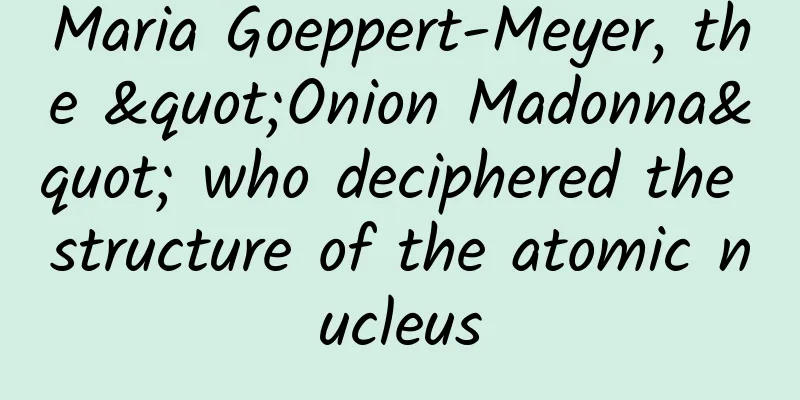Maria Goeppert-Meyer, the "Onion Madonna" who deciphered the structure of the atomic nucleus

|
February 20, 2022 marks the 50th anniversary of Maria Goeppert-Mayer's death. In 1963, she won the Nobel Prize in Physics for discovering the nuclear shell model of the atomic nucleus. She was the second female scientist to win the Nobel Prize in Physics after Marie Curie, and the third person did not appear until 2018. Maria's experience and achievements are rarely introduced. She was born into an academic family and grew up in the scientific holy land of Göttingen, but her academic path thereafter suffered discrimination because of her gender. But she eventually won the world's attention with her talent and perseverance. This article is dedicated to the memory of this true scientist. Written by Qu Lijian Maria Goeppert-Mayer (1906-1972) became the second female scientist to win the Nobel Prize in Physics after Marie Curie for her research on the structure of the atomic nucleus. She proposed that the atomic nucleus has an onion-like structure, so physicist Pauli called Mayer "The Onion Madonna". The story of Our Lady of Onion is as tear-jerking as an onion. February 20, 2022 is the 50th anniversary of her death. I am writing this article to commemorate her. Growing up freely in Göttingen Before Mayer got married, she was called Maria Goppert, and was born on June 28, 1906 in Katowice, Silesia, Germany (now Poland). Maria's family is an academic family, and her father has been a university professor for six generations. Maria's father, Friedrich Göppert, was a pediatrician. In 1910, when Maria was four years old, he was offered the position of associate professor at the University of Göttingen and moved his family to Göttingen, a famous university town in Germany. Friedrich Goeppert, a pediatrician and professor, hoped that his only daughter Maria would continue the glory of his professorial family. Friedrich paid great attention to cultivating his only daughter's interest in science. When Maria was 3 and a half years old, her father explained to her why the moon waxes and wanes. When Maria was 7 years old, her father made a lens for her to observe solar eclipses and patiently and carefully explained the principles of solar eclipses. He also took his daughter to the quarry to dig for fossils and to the forest to learn about plants. Friedrich was an atypical German father. German fathers of that era often kept a distance from their children. But Friedrich wanted to raise a child who was bold, loved learning, and dared to take risks. He even thought that the child's mother's weak character would hinder the child. When Maria was 8 years old, she often climbed trees. At this time, Friedrich always sent the child's mother away, fearing that the mother would hinder her daughter from releasing her nature. Maria in bat costume Maria suffered from headaches when she was a child, and this problem accompanied her throughout her life. Friedrich, a famous pediatrician, could not cure his daughter's illness. He encouraged his daughter, "I have tried my best to cure your disease and tried all options, but all failed. Now there is no choice. However, you still have two choices. One is to be defeated by this disease and label yourself as a patient; the other is to be strong, ignore the disease and live a normal life." Maria firmly chose the latter. At that time, many German girls only learned needlework and waited to get married when they grew up. Friedrich had high expectations for his daughter and encouraged her to "not be just a woman", meaning not to be a housewife. Maria promised her father: "I will not be just a woman." Maria aspires to become the seventh generation of professor in her family. In addition to being influenced by her father, Maria also met many world-renowned academic masters at the University of Göttingen, which was then the holy land of mathematics and physics in the world. Maria travels with the Born family Mathematician Hilbert and Maria were neighbors. Hilbert had a long blackboard in his garden for outdoor discussions. Maria once skipped classes to listen and was very interested. Every Saturday morning, Hilbert stood in front of the blackboard to give a popular science lecture to the public. Maria was not only a regular listener, but was also invited by Hilbert as a special guest. Maria's family and Max Born's family were close friends, and Maria often visited Born's home. Born regarded Maria as his daughter. Another Nobel Prize winner in physics, physicist James Franck, regarded Maria as his niece. In 1924, Maria was admitted to the University of Göttingen and began her academic career. Auditorium at the University of Göttingen College life What major should Maria study? Maria's initial idea was to follow in her father's footsteps and study medicine. Her father analyzed her personality and said that she was not suitable for studying medicine. Maria's father was a competent father who created a good growth environment for her and gave her pertinent advice at key points in her life. Maria decided to study mathematics. She was interested in mathematics, and Göttingen was a holy place for mathematics. Maria took all the courses taught by Born and impressed him with her excellent classroom performance. Born invited her to participate in his seminar. Soon, Maria became Born's favorite student. Then, there were rumors that the teacher and student had a private affair. Göttingen, where the IQ concentration is so high, has no bottom line when it comes to gossip. Maria's interest in physics grew day by day, and she switched to physics in 1927. Maria understood mathematics and physics in this way: "Mathematics is largely about solving problems... Physics also requires solving problems, but the problems in physics come from nature, not from the human mind." More importantly, Maria was particularly interested in the new quantum mechanics. Maria not only studied quantum mechanics on paper, but also participated in the construction of quantum mechanics on site, because Göttingen at that time was the source of major advances in quantum mechanics. From left to right: Weiskopf, Maria, and Born In Göttingen, Born and Frank jointly held a quantum mechanics seminar, where participants could interrupt the speaker at any time to express their own opinions or ask questions, or even make harsh criticisms. Maria and her classmates could even listen to Heisenberg talk about the ideas he had just obtained last night in class. Many scientific talents emerged from Maria's classmates, including the theoretical physicist Victor Frederick Weisskopf (1908-2002); molecular biologist and 1969 Nobel Prize winner in Physiology or Medicine Max Ludwig Henning Delbrück (190-1981), etc. The young man and woman soon fell in love. Weiskopf fell in love with Maria. However, it was not easy to win Maria's heart. Maria was a popular girl in Göttingen, and young men lined up to date her. This was not surprising, after all, the ratio of male to female students in Göttingen University was 9 to 1. Robert Millikan, who came to Göttingen to study, saw Maria and sighed, "I wish I had met her before I got married." The man who won the beauty's heart was Joseph Mayer, a young man from the United States. People called him Joe. Joe graduated from the University of California, Berkeley with a Ph.D. in chemistry. In 1928, he came to the University of Göttingen to work as a postdoctoral fellow with Frank, studying quantum mechanics. He was a tenant in Maria's house. Joe is eloquent, handsome, and rich. In Göttingen, if you can afford a bicycle, you are considered a "tycoon". Joe bought a "convertible sports car" which is very cool and made him the most handsome guy in Göttingen. Maria, Joe and Maria's mother riding in Joe's car Those who were frustrated in love spread rumors that Maria was attracted by Joe's car. In fact, Joe's biggest advantage was that, like Maria's father, he enthusiastically supported Maria's academic career as a professor. What's wrong with being a professor? Why didn't other guys support her? In addition to social prejudice, there were also very practical problems. At that time, universities almost never opened positions to women. For example, there was only one female professor of mathematics and physics at the University of Göttingen (Amy Noether). Even if you became a female professor, you didn't get paid. You taught students and did scientific research purely out of love. In 1929, Joe and Maria fell in love. Joe drove Maria to visit the Netherlands and visited the home of Paul Ehrenfest, a friend of Einstein and one of the best teachers in Göttingen. Maria talked about her dissertation non-stop. Ehrenfest suddenly interrupted her and said, "You talk very well. Have you finished it?" Maria replied, "Not yet." Ehrenfest said, "Then go and write it quickly. You can stay in the guest room and finish the outline. Don't come out until you finish it." Paul Ehrenfest (1880-1933) was an Austrian physicist who acquired Dutch citizenship in 1922. His main contributions were in the field of statistical mechanics, especially the theory of phase transitions. Maria entered Ehrenfest's guest room and was stunned. One wall was full of detective novels, another wall was full of biographies of famous scientists, and another wall was full of signatures of people who had lived here. Maria quickly completed the outline of the paper, sorted out the core issues of the paper, and signed her name on the wall. Maria and Joe returned to Göttingen. In January 1930, they held a wedding ceremony, and Maria took her husband's last name. After the honeymoon, Maria concentrated on completing her graduation thesis. Maria's doctoral thesis was a theoretical work that predicted that atoms or molecules could absorb two photons at the same time and jump to a higher energy level. Maria's theory was experimentally verified after the invention of the laser in the 1960s. In March 1930, Maria passed the defense and the final examination and received her doctorate. Maria's ambition was to become a university professor. In Germany, the hope of becoming a female professor was very slim, and American universities seemed to be more friendly to women. Maria decided to go to the United States with her new husband. A bumpy academic road On April Fool's Day in 1930, the Meyers arrived in the United States. Joe Meyer was offered a teaching position at Johns Hopkins University, but to their disappointment, Maria could not get one. This was the trend of American universities at the time, not to offer paid positions to professors' wives and relatives, the so-called anti-nepotism; coupled with the Great Depression, there were even fewer positions available at universities. The Johns Hopkins University (Hopkins for short) is a private research university with its main campus in Baltimore, Maryland, United States. Hopkins arranged a job for Maria similar to a research assistant, with a salary so low that it could be ignored. She had an office in the Department of Physics, could use the university's research facilities, and could attend classes. Maria took on a heavy teaching load and taught 6 courses. At that time, there were very few professors doing theoretical research in the Department of Physics at Johns Hopkins. There was a theorist, Karl Herzfeld (1892-1978), who did research in chemical physics, which was also the research area that Joe was interested in. Under the influence of the two people, Maria also entered this field. The three of them worked together to apply quantum mechanics to chemical problems, such as the structure of organic compounds. Their research on the spectrum of benzene was a milestone achievement in the field of quantum chemistry. Maria did not give up her research on nuclear physics. In 1935, she proposed the concept of double beta decay, which is when two protons in an atomic nucleus are simultaneously transformed into two neutrons and release two positrons, or when two neutrons are simultaneously transformed into two electrons. Both electrons and positrons are beta particles, so it is called double beta decay. From left to right: Joe Meyer, Maria Meyer, Karl Hertzfeld Maria had achieved so much, but her position at Hopkins was only a part-time research assistant. Joe felt sorry for his wife, as he knew that his wife was born to be a professor and should have a serious academic resume. Joe wanted to fight for his wife and get better working conditions and benefits. But Maria stopped her husband, saying that she was satisfied with the opportunity to do physics. Maria's highest salary was $200 a year, roughly equivalent to $4,000 today, and in 1935 the Physics Department was planning to cancel her salary. Professor Hertzfeld was extremely angry and wrote a letter to the president to speak up for her. In the letter, he listed Maria's achievements and value and asked the school to raise Dr. Maria Meyer's salary to $1,000. Hertzfeld's letter did not bring Maria a salary increase, but fortunately she was able to keep her salary at the time. In 1937, Maria was pregnant with her second child. She felt it was inconvenient to attend classes with a big belly, so she decided not to attend classes anymore and co-wrote a statistical mechanics textbook with her husband. While Maria was pregnant and writing a book, her husband Joe was laid off by the university. During the Great Depression, Hopkins' financial situation was so bad that the president decided to lay off all the high-paid professors. This did not cause any difficulties for the Meyers, because the University of Chicago and Columbia University immediately sent them job offers. Joe chose Columbia University. After their second child was born, they set off to New York. Columbia University, a world-class private research university located in New York, USA, is one of the Ivy League schools. At Columbia University, Joe's salary doubled compared to his time at Johns Hopkins University, but Maria's situation not only did not improve, but became even more difficult. This was not only due to the external economic environment, but worse, Columbia University had a strong atmosphere of discrimination against women. Isidor Isaac Rabi, a famous professor and nuclear physicist at Columbia University, said that women's neural structure is not naturally suitable for science. They can produce good science, but they cannot produce great science. Maria was given an office in the Physics Department. When George Pigram, the head of the Physics Department, found out, he told Maria that she was not welcome there. Maria resented Pigram for the rest of her life. Harold Urey (1893-1981), the head of the Chemistry Department and a Nobel Prize winner in Chemistry, arranged an office for Maria in the Chemistry Department and helped her obtain the title of Chemistry Lecturer. However, Maria was not happy in the Chemistry Department. She could attend academic seminars, but not the dinners after the seminars. Gradually, Maria even stopped going to seminars. Harold Urey (1893-1981) was an American scientist who won the 1934 Nobel Prize in Chemistry for discovering deuterium, an isotope of hydrogen. In 1953, Urey and Stanley Miller completed the classic experiment on the origin of life, the Miller-Urey experiment. In December 1941, Maria was going to Sarah Lawrence College, a women's college, for an interview for a part-time job. The interviewer asked: Is learning science as important as learning to burn a stove? Maria did not expect someone to ask such a question, so she asked back: Do students learn to read and write just to read recipes? Maria passed the interview and accepted the teaching job of the science integrated course, which is a course that integrates physics, chemistry, astronomy, etc. Although the concept of the class is relatively advanced and the teaching level is superb, the classroom environment is rather poor. The girls knit sweaters while listening to the class. This turned out to be her first formal paid job in her life. Soon, Maria got another part-time job. Yuri was in charge of a sub-project of the Manhattan Project and invited her to participate. In the project led by Yuri, Maria fully demonstrated her talents, which made her colleagues admire her sincerely and established her reputation in the academic world. After Japan's defeat and surrender, physicists who participated in the Manhattan Project left the military project and returned to academic research. A large number of physicists joined the University of Chicago and established an interdisciplinary institute for studying atomic nuclei. In 1946, the Meyers also came to the University of Chicago. The University of Chicago is a world-class private research university located in Chicago, Illinois, USA Nuclear structure At the University of Chicago, Maria was a "voluntary associate professor" and was soon promoted to a "voluntary professor", still an unpaid job. However, this time it was different, Maria didn't care at all, because here not only was no one discriminating her, but everyone admired her and everyone knew her level. Maria also became a member of the department committee, participating in important matters such as faculty recruitment, admissions, and student training. The difficulty of the University of Chicago graduate school entrance examination is well-known throughout the United States, and Maria contributed to this tone. She once said, "We are only interested in future Heisenbergs!" Among the students in the first exam after she participated, there were 4 Nobel Prize winners and 13 members of the American Academy of Sciences. The University of Chicago Nuclear Research Institute holds academic seminars every week. There is only one rule for the seminars: "Don't interrupt others' interruptions." This is quite a legacy of Göttingen. Maria knew she had come to the right place. Maria was even more passionate on the podium, and with the high-quality students, she was more relaxed when she taught. Maria was a heavy smoker. She held a cigarette in one hand and a piece of chalk in the other, puffing smoke while explaining the profound physics. She was so excited that she held the chalk in her mouth like a cigarette and burned the blackboard with the cigarette. At the same time, on the other side of the ocean, there was a folk song that was widely circulated, "The sky in the liberated area is a clear sky", which may best reflect Maria's mood at the time. At this time, she encountered a new job opportunity. One of her students at Hopkins was now the director of the theoretical department of Argonne National Laboratory and invited her to be a full-time professor. Maria was reluctant to leave her job at the University of Chicago, even though it was an unpaid job, so she only agreed to be a part-time professor at Argonne. Argonne National Laboratory agreed and offered her a good salary. Maria Meyer and colleagues at Argonne National Laboratory Maria's important research topic at Argonne National Laboratory is the cosmological model of the origin of elements. When Maria sorted out the relevant data, she noticed that the nucleon numbers of high-abundance isotopes had regularity. Nuclei with nucleon numbers of 2, 8, 20, 28, 50, 82, and 126 were particularly stable. These numbers were called magic numbers. Maria judged that magic numbers were important clues to cracking the structure of the nucleus. Others also discovered this regularity, but they did not expect it to be related to the structure of the nucleus. Maria continued to collect experimental data related to the atomic nucleus. The more data she collected, the more it showed that the atomic nucleus had a symmetry similar to that of the atom. Maria compared the electron shell structure of the atom and proposed that the atomic nucleus also had a shell structure. Inert gas atoms are particularly stable and difficult to react with other atoms. She believed that this was because the electrons filled up all the shells and it was difficult to gain or lose electrons. Similar to electrons in atoms, the energy levels in the nucleus are solved from quantum mechanics, called shells; protons and neutrons fill each shell, and some isotopes have all shells filled, similar to inert gas atoms, which are stable isotopes. In fact, this concept is not new, and it has been proposed before, but it was eventually abandoned because it does not make sense physically. The electrons form shell structures by long-range electrostatic forces, while the forces between nucleons are short-range forces. Maria wants to give a quantum mechanical explanation. Maria worked all day and went home at night. She was not tired but excited. She no longer asked the children about their daily life and studies. Instead, she lit a cigarette and talked to Joe about her new thoughts of the day. Joe also gave his own ideas. Although Joe was a chemist, Maria's questions were quite similar to valence electrons in chemistry, and she often gave inspiring opinions. At the University of Chicago, there was only one physicist who supported her ideas: Enrico Fermi, with whom Maria often discussed the matter. One day, Fermi and Maria were discussing the shell structure of the atomic nucleus in the office. At this time, someone came to ask Fermi to answer the phone. Fermi stood up, walked to the door, turned around and asked, "Have you considered spin-orbit coupling?" Then he hurried to answer the phone. Ten minutes later, Fermi came back from the phone and found that Maria was like a possessed person, talking non-stop like a machine gun, and her voice was so sharp that Fermi's head hurt. Fermi said, "Tomorrow, when you are calm, explain it to me again." Then he left the office with a smile. Fermi's words allowed Maria to integrate all her thoughts into a whole - the problem was solved. In Maria's theory, the nucleus is like a dance floor, and protons and neutrons are dancers, dancing the waltz in pairs, with the dancers themselves spinning, and a pair of dancers together making a big circle around the center of the dance floor. There will be multiple layers of big circles in the dance floor, which are the shells. Nuclear shell model Enrico Fermi and Maria Meyer Maria’s model successfully calculated all the magic numbers. The next step was to write the paper, and Maria procrastinated again, just as she had procrastinated on her thesis. Soon, news came that three German physicists had come up with a similar theory. Maria was still not in a hurry. Joe found this behavior unreasonable, and even Maria's colleagues at Argonne National Laboratory found it incomprehensible. This is Maria, humble, hates competition, and never thinks there is any value in defeating others. Maria could bear it, but Joe couldn't. One day, Joe put a pen in Maria's hand and ordered her to write! After Maria finished writing, she asked Fermi to sign it together. She knew that without Fermi's advice, there would be no paper. But Fermi refused and said, "This is your theory, I won't sign it." Maria knew that this was Fermi's way of promoting her. If Fermi's name was on the paper, her contribution would be underestimated. Jensen Monument at the University of Heidelberg, Germany. Johannes Hans Daniel Jensen (June 25, 1907 - February 11, 1973) was a German physicist who won the 1963 Nobel Prize in Physics for his nuclear shell theory. In the end, the work of German scientist Jensen and others was published first, which was almost exactly the same as Maria's work. Maria was a little disappointed at first, but soon changed her mind and thought that two people independently obtained the same theory, which meant that this theory was more likely to be correct and easier to convince others to accept it. Thinking of this, she felt relieved. Maria and Jensen did not compete for priority, but instead appreciated each other. Jensen wrote to Maria: "You convinced Fermi, and I convinced Heisenberg. What more can you ask for?" Maria and Jensen later became close friends and collaborators, and even had a romantic affair. It can be seen that the charm of the former heartthrob is still as strong as ever. In 1955, the two jointly published "Elementary Theory of Nuclear Shell Structure", which firmly established their status as the founders of the nuclear shell structure theory, which was unfair to Jensen's two collaborators. In 1954, Fermi, the soul of the University of Chicago's Nuclear Research Institute, passed away, and the institute fell apart, and scientists left the University of Chicago one after another. In 1959, the University of California, San Diego, extended an invitation to the Meyers. After the University of Chicago learned about it, it immediately made a decision to hire Maria as a full professor, but was rejected. The Meyers decided to work at the University of California, San Diego. In 1960, Maria finally became a full professor with full salary, 30 years after she graduated with a doctorate! Maria suffered a stroke not long after arriving at UC San Diego, paralyzing her left arm. Since then, her health has never recovered. However, she did not interrupt her beloved teaching and research career. In 1963, Maria shared the Nobel Prize in Physics with Jensen and her teacher in Göttingen, Wigner, becoming the second woman to win the Nobel Prize in Physics after Marie Curie. Maria Mayer and the King of Sweden at the 1963 Nobel Prize ceremony Maria published her last paper in 1966. On February 20, 1972, Maria Goeppert-Meyer died of a heart attack at the age of 66. Conclusion Maria Goeppert-Meyer was born into an academic family and grew up in a scientific holy land. However, due to the times, she could not have a formal position in an academic institution for 30 years, which is regrettable. Maria once said that if a woman wanted to be a scientist, she had to marry a scientist. When Joe was pursuing Maria, he said he would support her in becoming a scientist, and he did it. Maria's military achievements were half due to Joe's. Maria suffered all kinds of discrimination and obstacles in her career, but she also received strong support from upright scientists, such as Yuri, Fermi and other top scholars. However, if women want to have a smooth scientific path, we cannot just rely on good people to help. What is more important is the reform of the social system and the construction of a cultural atmosphere. Research has long shown that success in natural science has nothing to do with gender, and the gender gap is entirely due to culture. The whole society should have a more scientific understanding of gender differences in scientific professions and shape a more scientific social culture to help more women embark on the path of science. Following Maria Mayer, the third (Donna Strickland) and fourth (Andrea Ghez) female winners of the Nobel Prize in Physics were announced in 2018 and 2020. We look forward to more outstanding female scientists emerging in the future. References [1] Maria Goeppert Mayer: Physicist (Women in Science) by Joseph Ferry [2] Nobel Prize Women in Science: Their Lives, Struggles, and Momentous Discoveries: Second Edition by Sharon Bertsch McGrayne [3] Mei Zhenyue, Mrs. Meyer, Physics, 1984 Vol. 13 (8): 507-510 Special Tips 1. Go to the "Featured Column" at the bottom of the menu of the "Fanpu" WeChat public account to read a series of popular science articles on different topics. 2. Fanpu provides a function to search articles by month. Follow the official account and reply with the four-digit year + month, such as "1903", to get the article index for March 2019, and so on. Copyright statement: Personal forwarding is welcome. Any form of media or organization is not allowed to reprint or excerpt without authorization. For reprint authorization, please contact the backstage of the "Fanpu" WeChat public account. |
<<: Without giant pandas and leopards, how could it become China's first nature reserve?
>>: Is there really life on Venus?
Recommend
Don’t wear yellow or green clothes when you go out! Otherwise…
Recently, I always encounter some people walking ...
Birthday wishes to an African friend. How did you make the video of a black person saying happy birthday?
The creative videos of African friends have becom...
Download 97 episodes of Xu Zhengyang’s Eight House Feng Shui lectures from Baidu Cloud!
Download 97 episodes of Xu Zhengyang’s Eight Hous...
Solving the three major problems of Mount Everest: What black technologies did DJI drones use to set the highest transportation record?
Tuchong Creative Mount Everest was once a forbidd...
These 5 kinds of "vegetables" are actually staple foods, no wonder I can't lose weight!
Friends who are losing weight are always worried ...
2018 China Education Industry Promotion Trend Analysis Report!
As the saying goes, "You never stop learning...
Good news: Typhoon Makar is gone! Bad news: It’s coming again…
In the past two days, the super typhoon "Mak...
Four ways to update UI asynchronously on Android
As we all know, due to performance requirements, ...
APP promotion: How to acquire users through cold start?
Acquiring users is the beginning of achieving use...
How to do ASO for news and information apps - Taking Toutiao as an example
Abstract: The promotion of information apps repre...
Alipay's use of hormones is just a small mistake, but using Tianya and Tieba models to socialize is a big pitfall
In recent days, the circles of white-collar diari...
Huh? I came all the way to the Northeast, and you let me play with hot water and blow bubbles?
Harbin has been all over the news this year, and ...
How to promote and market APP? What are the common methods?
2019 marks the 11th anniversary of the App Store ...
"Shenzhou V" "Fengyun Satellite" appeared in Lingnan? It was made of lime!
The traditional intangible cultural heritage of L...
The sound of the mouse is wrong. The desktop is the soul of Apple.
The iMac may be a truck, but Apple is making sure...









